What Is Agri-Ecotourism?
Agri-ecotourism or agro-ecotourism is a mix of both ecotourism and agritourism. It’s a form of tourism that involves visitors participating in sustainable farming and learning about local produce. Known to be socially responsible and eco-friendly, the popularity of agri-ecotourism continues to grow as people look for new experiences outside of cities.
Whether it’s for leisure, education, or just curiosity, agri-ecotourism has managed to attract both international and domestic tourists. Driven by the need for more sustainable solutions and pastimes, this blend of interests has the potential to continue expanding in the future.


Difference between Agritourism and Ecotourism
Agritourism brings tourists to a farm or ranch to teach them about the local culture and increase income while ecotourism promotes sustainable and responsible travel to areas with the intention of conserving and protecting the environment. Ecotourism, also known as nature tourism, tends to be more focused on raising awareness for environmental issues. Both of these forms of tourism also work towards supporting the local community and encouraging a respectful mindset.
The combination of the two results in agri-ecotourism, a new and durable approach to tourism.
Why Do We Need Agri-Ecotourism?
There are many types of tourism that you may have heard of or even experienced first hand. Culinary tourism, business tourism, sports tourism, and even medical tourism – you name it. What makes agri-ecotourism stand out is that it is heavily focused on protecting the environment and reducing our carbon footprint while still providing an enjoyable holiday.
For guests, agri-ecotourism is an escape from busy city life. It gives them the opportunity to be surrounded by nature and immerse themselves in a new culture. Not only does this provide endless activities for travelers, but it also supports local farmers.
Agri-ecotourism can provide jobs in areas that normally have high levels of poverty, improve the food supply chain, strengthen traditional farming practices, and promote the local heritage through art.
Furthermore, it’s a great cause to promote because it works on conserving natural habitats and increasing landscape diversity. Because agri-ecotourism teaches people to be more responsible when it comes to their consumption habits, this change in mindset can be transformative for our society.
Agri-Ecotourism Activities for Guests
Agri-ecotourism is a lot more than just learning about the farming process. There’s an abundance of invigorating and memorable activities that guests can participate in when visiting eco-friendly farms. The best part is that it provides something interesting for all age groups.
If you own a vacation rental farmhouse , here’s a list of agri-ecotourism related activities that you can promote to your guests:
- Meeting local farmers
- Tasting a variety of fresh foods and produce
- Learning about rural art
- Farmer’s markets
- Visiting nearby protected areas and learning about their history
- Going on educational tours for a multitude of topics
- Milking cattle
- Winery tours
- Attending local festivals and fairs
- Renting out farmhouses or rural B&Bs to live out the full experience
- Workshops for corn grinding or traditional milk processing
- Learning about local architecture and construction
What Is Ecotourism? Definition, Examples, and Pros and Cons
- Chapman University
- Sustainable Fashion
- Art & Media
Ecotourism Definition and Principles
Pros and cons.
- Examples of Ecotourism
- Frequently Asked Questions
Ecotourism is about more than simply visiting natural attractions or natural places; it’s about doing so in a responsible and sustainable manner. The term itself refers to traveling to natural areas with a focus on environmental conservation. The goal is to educate tourists about conservation efforts while offering them the chance to explore nature.
Ecotourism has benefited destinations like Madagascar, Ecuador, Kenya, and Costa Rica, and has helped provide economic growth in some of the world’s most impoverished communities. The global ecotourism market produced $92.2 billion in 2019 and is forecasted to generate $103.8 billion by 2027.
A conservationist by the name of Hector Ceballos-Lascurain is often credited with the first definition of ecotourism in 1987, that is, “tourism that consists in travelling to relatively undisturbed or uncontaminated natural areas with the specific object of studying, admiring and enjoying the scenery and its wild plants and animals, as well as any existing cultural manifestations (both past and present) found in these areas.”
The International Ecotourism Society (TIES), a non-profit organization dedicated to the development of ecotourism since 1990, defines ecotourism as “responsible travel to natural areas that conserves the environment, sustains the well-being of the local people, and involves interpretation and education [both in its staff and its guests].”
The International Union for Conservation of Nature (IUCN) looks at ecotourism as a significant tool for conservation, though it shouldn’t be seen as a fix-all when it comes to conservation challenges:
“There may be some areas that are just not appropriate for ecotourism development and some businesses that just won’t work in the larger tourism market. That is why it is so important to understand the basics of developing and running a successful business, to ensure that your business idea is viable and will be profitable, allowing it to most effectively benefit the surrounding environment and communities.”
Marketing an ecosystem, species, or landscape towards ecotourists helps create value, and that value can help raise funds to protect and conserve those natural resources.
Sustainable ecotourism should be guided by three core principles: conservation, communities, and education.
Conservation
Conservation is arguably the most important component of ecotourism because it should offer long-term, sustainable solutions to enhancing and protecting biodiversity and nature. This is typically achieved through economic incentives paid by tourists seeking a nature-based experience, but can also come from the tourism organizations themselves, research, or direct environmental conservation efforts.
Communities
Ecotourism should increase employment opportunities and empower local communities, helping in the fight against global social issues like poverty and achieving sustainable development.
Interpretation
One of the most overlooked aspects of ecotourism is the education component. Yes, we all want to see these beautiful, natural places, but it also pays to learn about them. Increasing awareness about environmental issues and promoting a greater understanding and appreciation for nature is arguably just as important as conservation.
As one of the fastest growing sectors of the tourism industry, there are bound to be some downsides to ecotourism. Whenever humans interact with animals or even with the environment, it risks the chance of human-wildlife conflict or other negative effects; if done so with respect and responsibility in mind, however, ecotourism can reap enormous benefits to protected areas.
As an industry that relies heavily on the presentation of eco-friendly components to attract customers, ecotourism has the inevitable potential as a vessel for greenwashing. Part of planning a trip rooted in ecotourism is doing research to ensure that an organization is truly providing substantial benefits to the environment rather than exploiting it.
Ecotourism Can Provide Sustainable Income for Local Communities
Sustainably managed ecotourism can support poverty alleviation by providing employment for local communities, which can offer them alternative means of livelihood outside of unsustainable ones (such as poaching).
Research published in Proceedings of the National Academy of Sciences found that communities in regions surrounding conservation areas in Costa Rica had poverty rates that were 16% lower than in areas that weren’t near protected parks. These protected areas didn’t just benefit from conservation funds due to ecotourism, but also helped to reduce poverty as well.
It Protects Natural Ecosystems
Ecotourism offers unique travel experiences focusing on nature and education, with an emphasis on sustainability and highlighting threatened or endangered species. It combines conservation with local communities and sustainable travel , highlighting principles (and operations) that minimize negative impacts and expose visitors to unique ecosystems and natural areas. When managed correctly, ecotourism can benefit both the traveler and the environment, since the money that goes into ecotourism often goes directly towards protecting the natural areas they visit.
Each year, researchers release findings on how tourist presence affects wildlife, sometimes with varying results. A study measuring levels of the stress hormone cortisol in wild habituated Malaysian orangutans found that the animals were not chronically stressed by the presence of ecotourists. The orangutans lived in the Lower Kinabatangan Wildlife Sanctuary, where a local community-managed organization operates while maintaining strict guidelines to protect them.
Ecotourism May Also Hurt Those Same Natural Ecosystems
Somewhat ironically, sometimes ecotourism can hurt ecosystems just as much as it can help. Another study in the journal Trends in Ecology and Evolution found that ecotourism can alter animal behaviors in ways that put them at risk. If the presence of humans changes the way animals behave, those changes may make them more vulnerable by influencing their reaction to predators or poachers.
It's not just the animals who are at risk. As ecotourism activities become too popular, it can lead to the construction of new infrastructure to accommodate more visitors. Similarly, more crowds mean more pressure on local resources, increased pollution, and a higher chance of damaging the soil and plant quality through erosion. On the social side, these activities may displace Indigenous groups or local communities from their native lands, preventing them from benefiting from the economic opportunities of tourism.
Ecotourism Offers the Opportunity to Experience Nature
Renown conservationist Jane Goodall has a famous quote: “Only if we understand, will we care. Only if we care, will we help. Only if we help, shall all be saved.” It can be difficult to understand something that we haven’t seen with our own eyes, and ecotourism gives travelers the opportunity to gain new experiences in natural areas while learning about the issues they face.
Ecotourism also educates children about nature, potentially creating new generations of nature lovers that could someday become conservationists themselves. Even adult visitors may learn new ways to improve their ecological footprints .
EXAMPLES OF ECOTOURISM
The East African country has some competitive advantages over its neighbors thanks to its rich natural resources, paired with the fact that it has allocated over 25% of its total area to wildlife national parks and protected areas. Because of this, an estimated 90% of tourists visit to Tanzania seeking out ecotourism activities. Ecotourism, in turn, supports 400,000 jobs and accounts for 17.2% of the national GDP, earning about $1 billion each year as its leading economic sector.
Some of Tanzania’s biggest highlights include the Serengeti, Mount Kilimanjaro , and Zanzibar, though the country still often goes overlooked by American tourists. Visitors can take a walking safari tour in the famous Ngorongoro Conservation area, for example, with fees going to support the local Maasai community.
The country is also known for its chimpanzees , and there are several ecotourism opportunities in Gombe National Park that go directly towards protecting chimpanzee habitats.
Galapagos Islands
It comes as no surprise that the place first made famous by legendary naturalist Charles Darwin would go on to become one of the most sought-after ecotourism destinations on Earth, the Galapagos Islands .
The Directorate of the Galapagos National Park and the Ecuadorian Ministry of Tourism require tour providers to conserve water and energy, recycle waste, source locally produced goods, hire local employees with a fair wage, and offer employees additional training. A total of 97% of the land area on the Galapagos is part of the official national park, and all of its 330 islands have been divided into zones that are either completely free of human impact, protected restoration areas, or reduced impact zones adjacent to tourist-friendly areas.
Local authorities still have to be on their toes, however, since UNESCO lists increased tourism as one of the main threats facing the Galapagos today. The bulk of funding for the conservation and management of the archipelago comes from a combination of governmental institutions and entry fees paid by tourists.
Costa Rica is well-known throughout the world for its emphasis on nature-based tourism, from its numerous animal sanctuaries to its plethora of national parks and reserves. Programs like its “Ecological Blue Flag” program help inform tourists of beaches that have maintained a strict set of eco-friendly criteria.
The country’s forest cover went from 26% in 1983 to over 52% in 2021 thanks to the government’s decision to create more protected areas and promote ecotourism in the country . Now, over a quarter of its total land area is zoned as protected territory.
Costa Rica welcomes 1.7 million travelers per year, and most of them come to experience the country’s vibrant wildlife and diverse ecosystems. Its numerous biological reserves and protected parks hold some of the most extraordinary biodiversity on Earth, so the country takes special care to keep environmental conservation high on its list of priorities.
New Zealand
In 2019, tourism generated $16.2 billion, or 5.8% of the GDP, in New Zealand. That same year, 8.4% of its citizens were employed in the tourism industry, and tourists generated $3.8 billion in tax revenue.
The country offers a vast number of ecotourism experiences, from animal sanctuaries to natural wildlife on land, sea, and even natural caves. New Zealand’s South Pacific environment, full of sights like glaciers and volcanic landscapes, is actually quite fragile, so the government puts a lot of effort into keeping it safe.
Tongariro National Park, for example, is the oldest national park in the country, and has been named by UNESCO as one of only 28 mixed cultural and natural World Heritage Sites. Its diverse volcanic landscapes and the cultural heritage of the indigenous Maori tribes within the create the perfect combination of community, education, and conservation.
How to Be a Responsible Ecotourist
- Ensure that the organizations you hire provide financial contributions to benefit conservation and find out where your money is going.
- Ask about specific steps the organization takes to protect the environment where they operate, such as recycling or promoting sustainable policies.
- Find out if they include the local community in their activities, such as hiring local guides, giving back, or through initiatives to empower the community.
- Make sure there are educational elements to the program. Does the organization take steps to respect the destination’s culture as well as its biodiversity?
- See if your organization is connected to a non-profit or charity like the International Ecotourism Society .
- Understand that wildlife interactions should be non-invasive and avoid negative impacts on the animals.
Ecotourism activities typically involve visiting and enjoying a natural place without disturbing the landscape or its inhabitants. This might involve going for a hike on a forest trail, mountain biking, surfing, bird watching, camping, or forest bathing .
Traveling in a way that minimizes carbon emissions, like taking a train or bike instead of flying, may also be part of an ecotourism trip. Because these modes of travel tend to be slower, they may be appreciated as enjoyable and relaxing ecotourism activities.
The Wolf Conservation Center ’s programing in New York State is an example of ecotourism. This non-profit organization is dedicated to the preservation of endangered wolf species. It hosts educational sessions that allow visitors to observe wolves from a safe distance. These programs help to fund the nonprofit organization’s conservation and wildlife rehabilitation efforts.
Stonehouse, Bernard. " Ecotourism ." Environmental Geology: Encyclopedia of Earth Science , 1999, doi:10.1007/1-4020-4494-1_101
" What is Ecotourism? " The International Ecotourism Society .
" Tourism ." International Union for Conservation of Nature .
https://doi.org/10.1073/pnas.1307712111
https://doi.org/10.1371/journal.pone.0033357
https://doi.org/10.1016/j.tree.2015.09.010
https://doi.org/10.5897/JHMT2016.0207
" Galapagos Islands ." UNESCO .
" About Costa Rica ." Embassy of Costa Rica in Washington DC .
https://www.stats.govt.nz/information-releases/tourism-satellite-account-2019
- Costa Rica’s Keys to Success as a Sustainable Tourism Pioneer
- What Is Sustainable Tourism and Why Is It Important?
- What Is Community-Based Tourism? Definition and Popular Destinations
- How to Be a Sustainable Traveler: 18 Tips
- What Is Overtourism and Why Is It Such a Big Problem?
- Defeating Deforestation Through Rum, Chocolate, and Ecotourism
- Empowering Communities to Protect Their Ecosystems
- Best of Green Awards 2021: Sustainable Travel
- Why Bonobos Are Endangered and What We Can Do
- Why Are National Parks Important? Environmental, Social, and Economic Benefits
- IUCN President Tackles Biodiversity, Climate Change
- The World’s Smallest Tiger Is Inching Towards Extinction
- Ecuador Expands Protected Galapagos Marine Reserve by More Than 23,000 Square Miles
- What Is Voluntourism? Does It Help or Harm Communities?
- Regenerative Travel: What It Is and How It's Outperforming Sustainable Tourism
- New Zealand Aims to Become World's Largest 'Dark Sky Nation'

- Feeds Login
- English हिंदी मराठी ਪੰਜਾਬੀ தமிழ் മലയാളം বাংলা ಕನ್ನಡ ଓଡିଆ অসমীয়া ગુજરાતી తెలుగు
- MFOI Awards
- Weather News
- Profitable Business Ideas
- Latest Jobs
- More Topics

- Health & Lifestyle
- Success Stories
- Agriculture World
- Industry News
- Product Launches
- Commodity News
- Farm Mechanization
- Animal Husbandry
- Photo Gallery
- FTB Stories
- Agriculture Dictionary
- Web Stories
Subscribe to our print & digital magazines now
We're social. Connect with us on:
- Crop Calendar
- Subsidies from Government

Agro-ecotourism: A Potential & Sustainable Livelihood Option in the Indian Himalayan Region

The potential and forecasted footprint of both international and domestic tourists in the IHR is expected to be around 240 million tourists by 2025. It is now recognized that tourism can support sustainable development and achieve the millennium development goal of alleviation of poverty. Tourism has great ability to be one of the key development activities in the region, and ensure conducive conditions to address the issues of unemployment, revenue generation and the ability of IHR (Indian Himalayan Region) communities and the environment to absorb and equitably benefit from the impacts of tourism in a sustainable way. Ecotourism is defined as a form of tourism that entails responsible travel to natural areas and which conserves the environment and sustains the well-being of local people. Interest in visiting natural areas and observing wildlife is growing bringing opportunities at the same time building pressures on resources and the need for good management.
According to the United Nations, issues such as climate change, effective resource management, poverty reduction and inclusive growth need to be at the centre of tourism development. The Sustainable Development Goals (SDGs), which are now recognized as a universal 17-goal plan of action for people, the planet and prosperity for all countries require all stakeholders to act in collaborative partnerships. Apart from several other SDGs, mountain specific tourism is directly included as a target in Goals 8 and 12:
Goal 8 on the promotion of “sustained, inclusive and sustainable economic growth”, full and productive employment and decent work for all includes as Target 8.9 “By 2030, devise and implement policies to promote sustainable tourism that creates jobs and promotes local culture and products”.
Goal 12 aimed to “ensure sustainable consumption and production patterns” includes as Target 12.b to “Develop and implement tools to monitor sustainable development impacts for sustainable tourism which creates jobs, promotes local culture and products”.
Data for the last five years on tourist arrivals shows unprecedented growth in the IHR. The total number of tourist arrivals from 2011-2015 were 494 million which is 8.42% of the total national arrival (5,870,256,562). Further, it is expected that by 2025 (Figure 1) tourist footfall in IHR will increase multi-fold (estimated 240 million).
In this context agro ecotourism is an element within sustainable agriculture that addresses the acute threat to biodiversity by increasing landscape diversity, implementing the core principles of ecotourism and incorporating the essential practices of eco-agriculture and permaculture. It is a symbiotic relationship between tourism and agriculture where farmers and farms are an integral part of development and provide a positive economic approach to rural development. Agro ecotourism offers significant opportunities for the development of market niches based on the new food and nutrition experiences borne out of the traditional crops for the tourists, consumers and new educational experience by exposure to various agricultural production systems.
Agro ecotourism can be successful in rural and often remote areas where alternative sources of livelihood are scarce and levels of poverty are frequently high. It can provide a much needed addition to local income from an activity that values and supports conservation. However local communities should be involved in its planning and in the benefits it brings and attention must be paid to sound business planning and market access if it is to be economically sustainable and enhance the geographical character of place, its environment, culture, aesthetics, heritage and the well being of its residents (Figure 2).
It will enhance the linkages of the agriculture and food system with nutrition, health and socio-economic status of the people. Agro ecotourism can deliver more benefits to poor people through employment policies, strengthen the local food supply chain, provide assistance with enterprise formation and support for local services and infrastructure. It will stimulate the sustainable traditional farming practices and create mutual economic advantages through creative links between ecotourism and agriculture. It will encourage innovative product development and fair trade by strengthening links with the arts, handicraft and local heritage. It will result in all round conservation which will benefit the local communities. Agro ecotourism should be popularized in order to maximize the potential of well managed ecotourism as a key economic force for the conservation of nature. Agro ecotourism depends on fine landscapes and abundant wildlife. Therefore agro ecotourism development and the revenues it can bring should be seen as a strong ally and tool in their conservation. This involves strengthening the traditional knowledge skills and resources of protected area.

There is also need of agro ecotourism designing which will facilitate total harmony in its surrounding and leaving a minimal foot print and combining the traditional forces of inspiration with new technology. The viability and performance of agro ecotourism enterprises will strongly depend on the effective marketing, education and training of local communities. Poor farmers who are not skilled in finance or knowledgeable about markets and handling visitors need to be trained to develop skills. They need to be informed about markets and have access through the most effective channels including new technology. Agro ecotourism can help land owners in finding useful ways that they can afford to work their land. A major problem in central Himalayan region is the loss of the ability of the present land owners to utilize their land successfully in an economically feasible manner. The main obstacle facing present rural land owners is low return on agro activities. With every passing day it is becoming difficult to make money from the land. With the advent of tourism industry people can now augment their income. During peak tourist season i.e. spring and autumn when farm activities are less the local farmers can act as tourist guides, punters, bus drivers, housekeepers or cooks however they need to be made aware of tourist categories and that sometimes simple camping has to be replaced by ‘glamping’ (glamorous camping) where in sleeping bags, torches, match sticks and swiss knives will have make way for Persian rugs, extra-long beds with soft pillows, crisp sheets and blankets, 24 hours electricity, hot tubs and especially for the Indian MICE (meetings, incentives, conferences and exhibitions).
There is a need to establish a strong partnership between local communities' knowledgeable private sector tourism businesses, NGO’s and Government.

Agro ecotourism involves observing the indigenous people whose farming and herding practices that are part of their customary knowledge and cultural identity can be experienced firsthand (Figure 3). Experiencing authentic local tastes is an important part of what makes an eco-holiday enjoyable and memorable therefore traditional food has an important role in promoting agro ecotourism. Tourists from abroad are keen to watch and experience the traditional farming practiced in this region, even our city bred population who hardly has a chance to see a blade of grass grow may love to know about how the food that is served to him reaches him. Thus tourists may be keen to observe and participate in traditional agricultural activities such as ploughing, sowing, harvesting, collection of firewood and fodder and care for family livestock. Some typical community activity may include:
1. Guided and non-guided treks through villages (Figure 4) to meet people in their homes and fields belonging to different religion, castes, ethnic groups to learn about their work, belief, dress, home decoration and customs. Enjoy wearing traditional dresses and ornaments and even purchasing them as gifts and souvenirs.

2. Visit local artisans/craftsman and watch or join them working with traditional skills e.g. basket making, blacksmith/goldsmith etc. They can even enjoy traditional natural healing processes after visiting local traditional doctors called Vaidyas, gain knowledge on natural medicinal herbs and learn their traditional methods of identification.
3. Learn local cooking use of different flavouring spices, pickle making, tasting village cuisines which are not found in cities. Traditional milk processing, and enjoy fresh and pure milk products. Enjoy local drinks like Jaan , and salted tea that villagers drink to keep themselves warm in winter.
4. Watch traditional methods of oil extraction, husking paddy, and corn grinding by micro hydro powered mills called Gharat.
5 . Learn about construction of traditional house made of wood, stone and mud.
6. Learn about the local architecture widely depicted in local temples and religious and mythical stories about local deities.
When the tourism product is the traditional community life then the community must address the difficult challenge of maintaining the traditional authentic character. While developing the tourism industry the locals have to keep in mind the fragility of their community, limited carrying capacity, restricted budgets, economic goals and the responsibility of protecting their traditional agricultural base. Then tourists both national and international will come to witness and experience the community and its way of life – the epitome of agro ecotourism. Thus agro ecotourism can be a source of poverty reduction and environment management in the Indian Himalayan region.
Gaur et al. (2018) Report of Working Group II Sustainable Tourism in the Indian Himalayan Region, NITI Aayog
Paromita Ghosh and Sumit Rai*
1. G. B. Pant National Institute of Himalayan Environment & Sustainable Development Kosi - Katarmal, Almora - 263643, *Corresponding author: [email protected]
Related Topics
Share your comments.

Join our WhatsApp Channel and get the most important updates you need. Daily.

Top Stories

Important Tips for Maintaining a Healthy Paddy Nursery: Expert Insights

Sunflowers for Summer 2024: Explore Opportunities for Maximum Yield and Profits with Expert Tips

Loquat Cultivation: Farmers Can Earn Lakhs of Rupees by Cultivating this Surprising Fruit

Meet Vijay Dandime Who is Earning Rs. 2 Lakh from Guavas in a Sugarcane-Dominated Region

Are Miyazaki Mangoes Worth the Price? Find Out Why They're So Expensive!
Subscribe to our Newsletter. You choose the topics of your interest and we'll send you handpicked news and latest updates based on your choice.

Latest feeds
Upsc recruitment 2024 offers lucrative positions with high salaries; apply now, climate change linked to rise in diseases related to immune health, study finds, microbial food: a sustainable solution to global food crisis and climate change, bjp manifesto 2024: promising support for empowering farmers and revitalizing fisheries, fao and eu launch euro 15 million project to transform uganda's forestry sector, icar aieea 2024 registration now open: apply at icarpg.ntaonline.in for pg agricultural programs, government implements strict measures against pulse forward trading, upsc nda admit card 2024 released: download now at upsc.gov.in; check important details here, weather update: heatwaves likely across india; scattered rainfall in many parts.
- Latest News
Agro-Tourism: The Newly Emerging Tourism Niches
Importance of Simulation in Agribusiness
It is widely acknowledged that tourism contributes to economic growth in all of the world’s economies. By leveraging their potential for tourism, several nations have completely changed their economies. Many benefits, both direct and indirect, would result from tourism promotion for the populace. Large-scale employment and additional revenue streams for both skilled and unskilled members of the general public can be produced by tourism. The way that traditional travel is perceived has evolved. Agro-Tourism is one of the newly emerging tourism niches.
A significant issue that farmers face is their extremely low income, one of many that they face as significant stakeholders in the agriculture system. Farmers earn seasonal income instead of a monthly salary, which is insufficient to cover their essential expenses. Numerous factors impact farmers’ earnings. Some are covered in the section below. The climate is changing on a global scale. Farmers are also impacted by climate change. The output of crops is reduced as a result of severe weather. Sometimes there is little rain, and other times there is a lot of it, which destroys crops that are ready to be harvested. Crops are susceptible to disease.
Fields of crops are destroyed by these plant/crop diseases. Farmers are losing their livelihoods due in part to government policies. Farmers were unable to adequately spray their fields due to the increased use of fertilizers and pesticides, which led to a significant loss of crop yield. Agricultural systems rely heavily on farmers, yet sometimes unfair market conditions affect them. Farmer rates are extremely low, while some middlemen make significantly more than the farmers themselves. A farmer’s ability to make enough money to cover their basic expenses through the upcoming seasons is not assured, nor is their income guaranteed.
Therefore, farmers require income in addition to their regular income in order to meet their basic needs. Due to the fact that about half of farmers do not have enough land, our idea of contemporary agri-tourism farms can assist farmers in creating their own farm, which will increase their financial stability. There will be an admission charge that guests must pay. The target audience comprises farmers, the departments of agriculture and tourism, schools, colleges, and universities, as well as families. Visits to these model farms can be arranged by families and educational institutions. Visitors can learn about farming practices, crop stages, crop types, and seeding procedures in this model form. No preservatives are needed when eating fresh fruits from trees. In a natural setting, guests can savor regional cuisine served in a traditional manner. Watch some local singers perform.
Among the tourism industries that leverages rural culture as a draw for visitors is agro-tourism. All it is agriculture through tourism, or rather, tourism through agriculture commercialization. It is comparable to ecotourism with the exception that a cultural landscape rather than the natural one is its main draw. Agro-tourism is a novel agricultural pursuit that combines tourism and agriculture. It has the potential to greatly increase farmers’ employment opportunities and sources of income. Regional development can be aided by agro-tourism. Agro-biodiversity must have been valued and deserving of protection by the rural populace itself, as it also contributes to diversity conservation.
Some types of rural tourism exist that are not strictly related to agro-tourism , such as project tourism, adventure tourism, historical tourism, cultural tourism, ethno-tourism, and health tourism. In general, “agro-tourism” and “agro-ecotourism” are interchangeable.
Among the tourism industries that leverages rural culture as a draw for visitors is agro-tourism. All it is agriculture through tourism, or rather, tourism through agriculture commercialization. Bangladesh has great potential for the development of agro-tourism.
Most people agree that agro-tourism is a cutting-edge form of agriculture that combines travel and farming. It has the huge potential to give many stakeholders access to new revenue streams and job opportunities. Agro-tourism aids in the preservation of diversity and can support regional development.
Currently, the Gross Domestic Product (GDP) is used to determine the significance of agriculture. Thus, the primary analytical tool for policy considerations is foreign exchange earnings. Policy recommendations might be substantially different if the analysis’s primary focus were to shift to farm income as a gauge of agriculture’s economic contribution. Then, the focus would be on the farm’s earning potential and the farm family’s purchasing power, taking into account health and nutrition.
A strategy like this would highlight the real economic impact of agriculture and encourage policies that genuinely integrate the different industries. The rural areas would see an increase in production and productivity, bringing much-needed capital back into these communities.
By providing the utilities such as water, electricity, and health care necessary to utilize the resources of rural communities, an asset-based approach to community empowerment would significantly lessen the enduring issue of the urban-rural divide. There might be a nearly equal distribution of people in rural and urban areas due to the higher standard of living that is typically associated with urban living.
Destinations for agro-tourism or agro-fields suggestions
- Initially, guests should be greeted with warmth. The field of agro-tourism is also subject to the “first impression” principle.
- Attempt to maintain the fields, equipment, and premises in optimal condition. Customers or visitors will be happy if they are in good condition, and the reputation will be enhanced.
- Visitors should be given a comfortable and private atmosphere, with a preference for privacy.
- To guarantee their safety, equipment, etc., should undergo periodic proper maintenance. Goodwill will eventually increase as a result of this.
- Promote the use of all the amenities offered by the field or tourism centre to guests and tourists. It ought to go along with appropriate instructions for using facilities, equipment, etc. Sometimes it leads to improved relations with customers.
- Make sure there are adequate security measures in place for tourist destinations. Should the facilities be secured, patrons or guests will be eager to at least give them a try. For instance, life jackets, etc., when sailing.
- Contacting insurance companies is recommended if you’re interested in purchasing tourism-related insurance products. For tourism centers, it undoubtedly creates a feeling of relaxation. Fields, machinery, resources, buildings, lives, etc. should all be covered by such an insurance policy.
- For better customer service and the health of visitors, tourism organizers or centers must steer clear of dangerous machinery, procedures, facilities, etc. Using pesticides and poisons, for instance. We must, at all costs, promote and put into practice organic farming and related practices. Occasionally, it will cost money in the beginning, but ultimately, profits will be realized. One useful tool for guidance will be a projected life cycle cost benefit analysis.
- In agro-tourism centers, emphasize plastic-free travel. These days, governments and organizations spend enormous sums of money recycling their plastic waste. With visitors’ and other stakeholders’ cooperation, agro-tourism organizers can maintain a plastic-free facility from the start. The opportunities that present themselves as challenges to agro-tourism centers must be investigated. It is therefore advised that they be alert in spotting them and making them into the most lucrative endeavors.
- When it comes to greeting guests, make the necessary seasonal arrangements. The arrangements for each season may vary from the others. Thus, prepare for the arrangements and take the necessary steps to put the decision about them into action, including making financial arrangements.
- Agro-tourism destinations would be better off adhering to government regulations regarding tourism on a voluntary basis than by using coercion. The agro-tourism center’s reputation will eventually rise as a result of this process.
- Tourism centers are primarily responsible for verifying the identities of visitors to agro-fields. In addition, the law requires it to guarantee the nation’s security, particularly its economy. Transform the agro-tourism destination into a marketplace where people can buy goods and receive a range of services. It covers informational services, local tourism expertise, etc.
- Provide jobs that are essential to the agro-tourism centers’ efficient operation. For the tourism destinations’ reputation, it is imperative.
- To ensure local support for the venture, preference may be given to locals when filling employment vacancies necessary for the efficient operation of agro-tourism centers. The optimization of reputation will occur from the availability of workers, employees, or helpers on short notice via phone call.
Recommendations for Guests or Travelers
- It is advised that guests take the necessary initiative to ensure their own safety. This safety pertains to using tools, procedures, and participating in events and festivities related to agro-tourism.
- In order to develop a comprehensive view of the field, tourists visiting agro-tourism destinations should make an effort to explore and enjoy the area more by making use of all the resources available to them.
- The goal of creating a business environment for visitors to the firm is to be acquainted with its policies and practices. Using an adventurous spirit can be highly valued in order to make the agro-tourism experience unforgettable.
- Since that “God’s own country” is never immune to natural or man-made disasters, it is imperative that guests be prepared for these events.
Recommendations to other interested parties, such as society
- To get social support for agro-tourism, the public needs to be educated and made aware of agro-tourism.
- The general public, or members of society, ought to understand that agro-tourism promotes social welfare.
- Support the plastic one excellent thing the community can do to support agro-tourism is to offer free travel. Agro-tourism initiatives can only achieve enormous success with the assistance of all stakeholders.
Proposals to the Government
- As much as possible, make sure that all parties involved are properly safe. Safety, both mental and physical, is usually involved. The enjoyment of agro-tourism destinations will increase if the stakeholders are freed from the typical safety concern.
- Enough actions must be performed to encourage innovation in the agro-tourism industry . Visitors are undoubtedly drawn to agro-tourism fields that offer innovative techniques, methods, or programs.
- Celebrate agricultural achievements in tourist hotspots or visually appealing locations that are accessible to tourists and other interested parties. A major component in drawing in the stakeholders will be celebrations. Along with other potential partners, the government must make sure that there is adequate transportation for the guests. Routes that are not entirely clear can occasionally be a hindrance to the growth of tourism overall and agro-tourism specifically for developing country.
- Upkeep of an information system is required as a government project. Included in it should be all the necessary and pertinent details about agro-tourism destinations, routes, amenities, costs, etc. A system like this would not only benefit the tourists but also lessen the government’s burden. The government will use its authority to regulate the costs of goods and services provided in agro-tourism locations to safeguard the interests of tourists, who are vital to the success of any tourism endeavor. It also adds a constraint on exploitation.
- In order to improve the state’s educational system, agro-tourism courses must be added while studying agriculture. Updates must be made to the curriculum in this regard. These could be sorted and used with existing expert groups.
- To promote agricultural and agro-tourism, farm visits by academics and students with their instructors should be promoted. The industry visits carried out by reputable educational institutions must be compared to farm visits. Ascertain that the tourism industry generates the greatest number of jobs, particularly in agro-tourism areas. A state staff selection authority consultation is required before filling any vacancies. At that point, the general public can only regard white-collar jobs related to agriculture as being on par with government jobs.
- Encourage travel destinations to join the plastic-free campaign. All forms of government and their apparatuses ought to view it as a challenge. In the end, it might lead to some degree of green tourism.
- Adequate steps need to be done to overcome disasters. Basic requirements, life-saving gear, first aid kits, transportation, etc. should all be part of these precautions.
#agrotourism #farmstay #farmtourism #agritourism #sustainabletourism #ecotourism #ruraltourism #slowtravel #experiencetravel #getoutside #agritravel #agrotraveler #wanderlust #adventure #naturelover #foodie #travelgram #instagood #instaphoto #travelphotography
If you have any questions, thoughts, or suggestions, please contact us or join our social media networks.
Email us: [email protected] , [email protected]
Feel free to comment:
Your email address will not be shared with anyone..
Join our LinkedIn group
https://www.linkedin.com/groups/13943442/
Join our Facebook group
https://www.facebook.com/groups/agribusinesseducationandresearchinternational
Read More:
Effective marketing channels for agricultural marketing
4IR impact on agriculture
What is Agricultural Technology?
What is Smart Agriculture?
Application of Drone in Agriculture
Scope and Importance of Agricultural Marketing
What are the Characteristics and Traits of an Entrepreneur?
Why is market information important?
Agribusiness how it works?
Covid -19 Pandemic Impact on Agribusiness
What is Agribusiness?
E-Commerce and Supply Chain Finance
Technology Application in the Financial Section of Agribusiness
What is Supply Chain Finance?
Role of IT in supply chain management in Agribusiness after Covid 19 Pandemic
Agile supply chain in Agribusiness
Supply chain Management Networks in Agribusiness
Strategic sourcing for supply chain management strategy
What is the supply chain management process in Agribusiness?
What is Supply Chain Management in Agribusiness?
Supply chain Management and Agribusiness
9 Signs Your Dairy Cows Need a Calcium Lift

Farmer success in high-yield rice cultivation under IRRI supervision in hilly areas

Factors Affecting the Cost of Agricultural Marketing
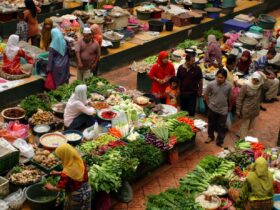

What is Agritourism
Have you ever toured the countryside? Made a holiday of sampling home-made food items, purchased local handicraft as souvenirs or spent a day plucking delicious looking fruits and vegetables from the plant? Agritourism is exactly this!
As consumers, it is important to maintain a healthy relationship with our food, and to gain knowledge about the source and history of it.
According to the Food and Agriculture Organization , Agritourism is ‘The symbiotic relationship between tourism and agriculture.’ In a simple context, agritourism also known as agrotourism, is a form of tourism which activities are focused directly with agriculture, and utilises the unique offerings of rural and agriculture rich communities.
Agritourism is a form of tourism which can be employed in almost every corner of the globe. The requirements of the world to have some form of agriculture, animal keeping, and the resources which it provides: food, medicinal plants, milk, wool, meat, etc are necessary to keeping the world fed. As such, rural areas abound, bringing with them a unique opportunity for tourism.
Some examples of agritourism are:
- Visiting farms to pick and purchase produce
- Learning about environmentally-friendly or historical means of agriculture
- Helping to bring tourism efforts into rural communities
- Participating in planting or harvesting activities in rural, agriculture based communities
- Visiting rural areas for tasting and purchasing locally made juices or wines
Why is agritourism important?
Agritourism is important for many reasons. It helps to generate additional income for producers, it generates an atmosphere where people can learn about agriculture and foster a deeper connection to the source of their food and it creates the possibility for the visitor to discover a better source of food purchasing which benefits the community at a more local level and not just multinational corporations. Also, a day spent in the countryside under a clear blue sky with fresh air and exercise is usually considered a good day!
Agritourism and ecotourism come together on several points. These points being: contributing to small communities through the travellers tourism choices and purchasing decisions, having the opportunity to learn about the history of – and environmental activities of the place which is being visited, utilising the sources of a local guide and rural conservation efforts are applied.
How can we find agritourism options?
Agritourism options, both local or in a far flung destination, can be found by doing a simple online search. As many small farms do not employ a team of marketers, agritourism options are not likely to be found via the more mainstream ways of destination marketing. Doing a quick online search will give results, especially if it is an unfamiliar destination about which you are searching. There are a few online listing sites for agritourism activities – including expedia and book agri websites.
If you are looking for a more local option, word of mouth is usually one of the best ways to find a good agritourism option, as people will always include a personal recommendation or word of caution when discussing the place and their experience with it. A recommendation from a friend, family member or friendly local usually carries more value than an online recommendation from a stranger.
Look out the window! When taking a long drive, be it for working or any other reason, look out the window. Make a note for remembering to yourself when you notice a sign on the road advertising local farms or the ability to pick your own fruits at the named place. Keep the phone number or farm name and when you are looking for agritourism options, call and ask information from them first.
Enjoy some time in the countryside, you’ll be happy you did!
Would you like to receive more articles like this directly to your email inbox? Please register for our newsletter by clicking here !

You May Also Like

Booking Sites for Sustainable Travel: Vol. 1


10 Reasons to Try a Village Stay

Exploring the Great Examples of Agritourism

What is agritourism and why is it growing so fast?
Disclaimer: Some posts on Tourism Teacher may contain affiliate links. If you appreciate this content, you can show your support by making a purchase through these links or by buying me a coffee . Thank you for your support!
Agritourism is a type of tourism that is increasing around the world. With the increasing popularity of niche tourism , coupled with a growth in the desire to make our travels more sustainable , it is no surprise that the agritourism industry has grown significantly in recent years. But what exactly is agritourism and how does it work? Keep on reading to learn more….
What is agritourism?
Definition of agritourism, types of agritourism, direct-to-consumer sales, agricultural education, hospitality , entertainment , the advantages of agritourism, the disadvantages of agritourism, agritourism in the philippines , agritourism in the uk, agritourism in australia, agritourism in india, further reading.
Agritourism is a type of experiential travel . It involves doing something on your trip or holiday, and therefore experiencing the country or destination more so (and more deeply) then if you simply visited on a relaxing holiday. More specifically, agritourism involves doing something that is related in some way to agriculture.
Agritourism takes many different forms and comes in many different shapes and sizes. Some examples include:
- Wine/vineyard tours
- Glamping/camping
- Quad biking
- Horse riding
- Fruit/flower picking
- Volunteer tourism
- Animal farms parks/safari parks
- Staying in a homestay located on a farm
- Educational visits
- Relaxation retreats
- Hunting trips
- Rural weddings/events
- Farmer’s markets
- Bird and wildlife watching
- Nature centres
Agritourism comes with economic benefits for travellers and for other tourism stakeholders (farmers, ranch owners and so on). In fact, it is necessary for the survival of some small farms. It diversifies farmers’ income streams, meaning they are able to make money outside of their regular season. By farms offering agritourism opportunities, too, surrounding areas and local communities see an increase in people visiting or passing through. This of course means an economic boost for rural areas and is an example of a positive economic impact of tourism !

Agritourism is also a more eco-friendly and immersive way to travel. It allows people to have experiences they may not get elsewhere, meet local people, see ‘off the beaten track’ locations and more. Agritourism can open our eyes to more sustainable practices, and this is very important in 2021. With the rise of ecotourism, it is no surprise that agritourism is becoming more popular as time goes on.
Agritourism is tourism that involves any agriculturally based operation or activity that brings visitors to a farm or ranch. It of course comes from the term ‘agriculture’. This is the science or practice of farming, including cultivation of the soil for the growing of crops and the rearing of animals to provide food, wool, and other products.
A further definition of agritourism by the North Carolina Agritourism Activity Liability Law states that it is: Any activity carried out on a farm or ranch that allows members of the general public, for recreational, entertainment, or educational purposes, to view or enjoy rural activities, including farming, ranching, historic, cultural, harvest-your-own activities, or natural activities and attractions.
It doesn’t necessarily have to include travelling abroad. A simple visit to a petting zoo or local farm definitely counts as agritourism!
There are typically 5 types of agritourism. The Journal of Agriculture, Food Systems, and Community Development labelled these as:
- Direct-to-consumer sales
- Hospitality
- Recreation
I’ll dive a little deeper into each of these categories in the next section of this article. There are so many ways to experience and enjoy agritourism both in your local area and further afield. Sometimes – in fact, most of the time – you aren’t knowingly or purposefully participating in agritourism, but as there are so many examples you’ve probably been lucky enough to try one of them!

Below you can find out more information about each of the 5 types of agritourism based on the Journal of Agriculture, Food Systems, and Community Development definitions. There are likely to be examples that you have already experienced yourself, as well as others you might not have considered or even heard of yet…
This includes farm stands and ‘pick your own’ experiences. A farm stand is, as the name suggests, somewhere you can visit to buy produce directly from a farm. A farmers’ market is similar to this – somewhere you can visit to purchase goods from different farmers who have travelled to one location to sell their produce. This can range from eggs to cheese to meat. Farms also often have shops attached to them, selling produce as well as items from local crafters, makers and more.
You can also visit farms to pick your own goods. In the spring this might be strawberries or other types of berries, and in the autumn months leading up to Halloween it’s all about pumpkin picking. If you’ve been to your local pumpkin patch with your little ones to snap some cute shots for Instagram (which is known as Instatourism , by the way), then you have participated in agritourism! And who could resist those gorgeous orange tones on the grid?
Did you know: the pick your own strawberries trend in the UK was pioneered by Ted Moult in 1961. He was a British farmer at Scaddows Farm near Ticknall, Derbyshire, who went on to become a radio and television personality.
School trips to local farms fall under this category of agritourism. You might also, as an adult, visit a farm and enjoy a guided tour where a farmer or farm assistant explains different aspects of the farming industry to you. This would be a type of agritourism as well as a type of educational tourism , although it is just a small part of agricultural education as a whole – for example, tertiary education locations such as Reeseheath College in Nantwich, UK.
In terms of agritourism as proper tourism , e.g something which involves travelling outside of your hometown for a holiday, this category is where it starts. From family-friendly interactive farms to relaxing adult only retreats complete with hot tubs, there are various different farm stay options across the world. You might take the kids camping somewhere with a petting zoo, or stay in a shepherd’s hut with your other half enjoying scenic views and milk in your tea courtesy of the cows on site. Farmstay.co.uk offers a huge range of accommodation on working farms in the UK, and this is likely to be replicated worldwide.

You can actually book farming holidays, too. This is where you rock up at a farm and work in exchange for accommodation! WWOOF , or the Worldwide Opportunities on Organic Farms, facilitate this globally. They connect travellers with farmers, and you can have a really affordable holiday this way. As long as you’re prepared to put the work in, that is! There are farms you can work on in Mexico, Portugal, Serbia, Myanmar and so many more incredible locations.
Hunting, horseback riding, meeting donkeys on the seafront… all of these are recreational types of agritourism. Whether you go on an organised hunt in a rural location or choose to ride a horse across the desert, these are types of agritourism. Hunting doesn’t just mean animals, either; you could go truffle hunting! Horseback riding is also something that is offered worldwide as a fairly standard tourist activity – from Petra in Jordan to the beaches in The Gambia , it is a great holiday activity.
The final type of agritourism is entertainment. Although the above categories are entertaining in themselves, this is slightly different. The entertainment category includes hay rides, which are popular in the US especially and involve a hay-lined truck or tractor ride. Other countries have started to adopt this activity, and it is also popular when it comes to Halloween – haunted hayrides are a great way to celebrate spooky season.
Agritourism is a fantastic way for farmers to diversify their income and to make some extra cash. With increasing issues such as droughts or increased competition, farmers are often susceptible to financial loss should they have a bad season. However, agritourism can be a great way to compensate for this!
Agritourism can have its disadvantages also. Tourists visiting farmland may have negative environmental consequences – trampling the ground or by frightening/displacing local wildlife. The introduction of agritourism can also take the attention away from traditional farm work. Over dependance on tourism is a bit problem in many parts of the world, and it is important that farm owners do not entirely abandon their traditional methods of making money… because should something happen to discourage tourists from visiting (an illness, political unrest, a natural disaster etc) then there would be no money coming in…
Examples of argritourism around the world

Agritourism takes place all around the world, with more and more agritourism businesses popping up all the time. Here are some examples:
Agritourism is popular in the Philippines. It has a gorgeous tropical climate that makes it well suited for this type of tourism, as well as fertile soil and plenty of natural resources. Their natural resources are abundant, and the people are lovely. Agritourism in the Philipines is a rich and fruitful experience, leaving you with lasting memories and a whole new view of this part of the world. According to Kapwa, a Filipino travel company, some of the country’s most popular agritourism activities include “vegetable- or fruit-picking, sampling of local wines, planting rice or root crops, visit to organic farms, milking cows, riding carabaos, catching fish, coffee bean picking, farm-to-table dining, and more.”
As mentioned earlier, farm stays are really popular in the UK. Being a country so full of towns and cities, people find it novel to stay somewhere more rural. With travel restrictions in place during the COVID pandemic, staycations (many of which were in rural areas) in popularity across the UK. From shepherd’s huts to glamping to cosy cottages, there are plenty of agritourism options across the UK.
Another place that sees a lot of agritourism is Australia . This is because second-year visa requirements say : to earn the right to a second year visa you must work in one of Australia’s more remote areas – the kind of places where travelling to the nearest town takes about as long as travelling to a whole other country in Europe. The job must be paid (in the past voluntary work was eligible) and the work hours must constitute a full-time job.
Farming work obviously falls into this category, and as hard as it is people say some of their best memories of Australia are from working on farms. It is a chance to meet other people who are travelling across the country, and you’ll feel proud of your hard work!
Farming is vital to India and its economy, and as such agritourism has been incredibly beneficial to tourism in India. You can stay on many of the working farms across this stunning country. From milking cows to lazing in a hammock, walking through plantations and learning how to cook with produce from the farm itself, there are so many amazing opportunities when you enjoy what India has to offer in terms of its booming agritourism industry.
If you have enjoyed reading this article, I am sure that you will love these too:
- Niche tourism: What, why and where
- Educational tourism: Everything you need to know
- Ecotourism in Costa Rica: Where to go and why
- MICE tourism: A simple explanation
- What is an eco lodge? | Understanding tourism
Liked this article? Click to share!

Sustainable Agriculture Research & Education Program
Agritourism.
University of California researchers define agricultural tourism (agritourism) as any income-generating activity conducted on a working farm or ranch for the enjoyment and education of visitors. It includes the interpretation of the natural, cultural, historic, and environmental assets of the land and the people working on it.
The Agricultural Marketing Resource Center (AgMRC) provides a list of business activities that it categorizes as agritourism. Examples of agritourism activities include but are not limited to U-Pick farms, on-farm markets, pumpkin patches and corn mazes, outdoor recreation, farm stays, demonstration farms and more. The purpose of these enterprises is multi-faceted. As the U.S. Natural Resources Conservation Service (NRCS) describes it: “farmers and ranchers rely on the natural resources of their land - the soil, water, air, plants, wildlife, and scenery - to keep their family on the farm and the farm in their family.” Agritourism can play a role in maintaining the land’s resources and enable the development of a more sustainable food system.
**This page gives general information about agritourism as an important part of sustainable agriculture. If you are interested in learning about our Agritourism program, which includes resources, training, and a website for farmers to promote their operations, visit our agritourism website.

Agritourism activities can provide the supplemental income necessary to allow for the preservation of small and mid-scale farms, ranches, and rural communities. It can be promoted as an outlet for local residents and tourists to experience direct contact and interaction with agriculture and natural resources. Increasing public interaction with local farms and ranches can promote an understanding and appreciation for the working landscapes that help maintain or enhance natural resources.
Long-term agritourism sustainability depends on preserving the quality of the nature-based environment that includes productive agriculture. The AgMRC outlines seven best management practices for an agritourism business – authentic experience, educational experience, customer service, adequate facilities, safe and accessible environment, community relations, and planning for a financial future. Many agritourism operators express a desire to educate visitors or as a tool for community outreach as some of the key motivating factors in implementing and managing their tourist-focused activities. The vast majority of the US population is not directly engaged in agriculture; agritourism efforts provide an opportunity for these individuals to engage with their local food system. These types of interactions may empower individuals to make more sustainable food and lifestyle choices and can increase the extent of rural advocacy among city dwellers.
Permitting issues, environmental health regulations, and liability or insurance concerns were the three most prominent factors limiting the implementation of agritourism. The UC Agricultural Issues Center found that the permitting system was overwhelmingly viewed by farm operators as misleading, time-consuming, or costly ( AIC Issues brief ). In order to obtain clearances, permits, and licenses, operators must follow a planning and permitting process that addresses land-use development, environmental health and safety, licenses and taxes, and direct marketing. Rules and regulations for agritourism operations vary by county, increasing the potential for miscommunication or misunderstandings within the system. Refer to the California Agritourism: Permits and Regulations webpage for information on the best approaches for meeting the regulations required to begin and sustain an agritourism operation.
University of California Contributions - Research
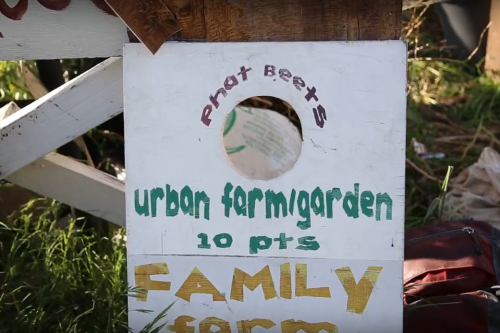
UC has engaged in a variety of research initiatives and programs aimed at promoting the development of sustainable agritourism. To investigate the political, social, and economic characteristics of agritourism in California, researchers from UC Cooperative Extension and the UC Small Farm Program performed an extensive survey of farmers engaging in various agritourism practices in 2009. With this information, researchers are able to better understand the needs of California agritourism and create outreach programs to assist in the development of the sector. The UC survey team focused on determining the types of activities that farmers were engaged in, marketing techniques, management and staffing practices, profitability, and the characteristics of typical visitors. Detailed survey information was published in UC ANR’s quarterly journal, California Agriculture: California agritourism operations and their economic potential are growing.
The survey determined that more than 2.4 million visitors participate in agritourism activities yearly. Although the California wine business plays a critical role in the agricultural economy of the state, the survey only included small wineries (those producing fewer than 10,000 cases annually) that were also engaged in non-wine-related agritourism activities. It is estimated that the wine industry attracts an additional 21 million tourists spending $2.1 billion each year within the state. More information on the California wine business can be found on the Wine Institute’s website or through the UC Davis Viticulture and Enology department.
The survey found that 68% of farms offering agritourism activities were considered a “small farm” by the USDA. These farms operate with gross annual sales of less than $250,000. Income diversification is a crucial aspect for small-scale farms to maintain economic viability. Supplementing traditional production with agritourism practices can help buffer seasonal fluxes in farm income and market volatility. Roughly 75% of the survey respondents indicated that they were motivated to implement agritourism practices as a method of increasing profitability. In a different study to better understand the market and resources realistically available to farmers, UC researchers studied the economic impacts of agritourism . This report found that especially at the urban-rural interface, agritourism provides economic incentives for growers, opportunities for product diversification, and helps to educate the public about the importance of supporting local agriculture.
UC Contributions - Outreach and Community Involvement
To meet the needs of small-scale farmers in California the UC Cooperative Extension established the UC Small Farm Program in 1979 which operated as a statewide program of UCANR until 2009. This program developed field and marketing research aimed at the needs of small-scale farmers who may not be reached by traditional extension programs ( Small Farms Program 15 yr report ). Small Farm Advisors continue to work from county-based Cooperative Extension offices and are organized as the UC ANR Small Farms Network .
In addition to ongoing extension efforts by program coordinators and county advisors, UC has several publications to assist farmers and ranchers in establishing agritourism into their businesses. In 2006 Desmond Jolly, with the UC Small Farm Center, published A Handbook for Planning and Managing Agritourism and Nature Tourism Operations . ANR offered a 2011 revised edition of Agritourism and Nature Tourism in California . Written by UC Cooperative Extension advisors, Holly George and Ellie Rilla, this book is used as a teaching guide by the statewide agritourism workshops.
Agritourism efforts are now housed at UC SAREP under the direction of Rachael Callahan , the Statewide Agritourism Coordinator. She manages the UC SAREP Agritourism program’s website and writes the California AgTour Connections e-newsletter . The website provides news, fact sheets, and additional resources including the UC Agritourism Directory and Calendar .
Callahan helps organize workshops, classes, and lectures, such as the Agritourism Intensive three-session course designed to familiarize small-scale farmers with the regulations and management needs of agritourism operations. Callahan mentions there have been at least 2,000 ranchers and farmers who have participated in these workshops, which provide opportunities for participants to meet the visitor bureau and the county staff, attend field trips and start their own business and marketing plans. Since 2011, the UC Small Farm Program and then UC SAREP has worked with partners to provide resources, such as summits, trainings and guides for agritourism operators. Examples of projects include Agritourism Intensive Trainings , Building a Farm Trail Project , a guide for Marketing Regional Farms and Wineries , and Regional Agritourism Summits (2017) .
UC Resources
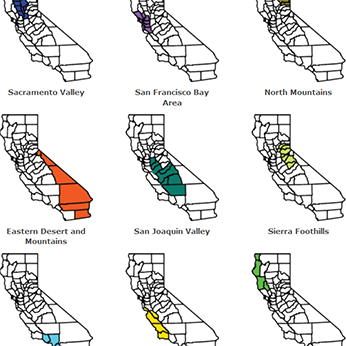
The UC Division of Agriculture and Natural Resources maintains a directory of agritourism operations in the state of California.
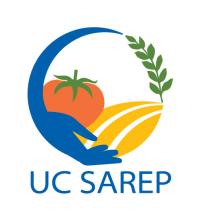
The UC Sustainable Agriculture Research and Education Program houses an agritourism program t hat works with county-based UC Cooperative Extension farm advisors, provides resources for agritourism operators and hosts California's statewide directory and calendar of agritourism operations.
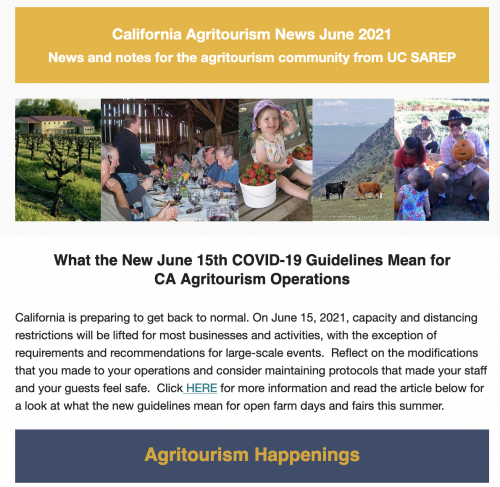
The California AgTour Connections e-newsletter is a chance for growers, agritourism operators, county staff, tourism professionals, and others to keep up with news and information.
Contributors: Leigh Archer, Bev Ransom, Mariah Coley
How to cite this page UC Sustainable Agriculture Research and Education Program. 2017. "Agritourism." What is Sustainable Agriculture? UC Division of Agriculture and Natural Resources. <https://sarep.ucdavis.edu/sustainable-ag/agritourism>
Agritourism Is the Concept of Vacationing on a Farm—Try It Out at These 10 Pastoral Properties
The terms "agritourism" and "farm stay" are often used interchangeably. Whatever vernacular you assign to the purpose-built experience, though, know that this booming part of the ecotourism sector delivers something from which so many of us could benefit: more time outside, and the opportunity to experience an agrarian way of life. And it appears to be here to say: According to market research , the nearly $6 billion market size of agritourism, as of 2021, is predicted to grow at a rate of 11.4 percent through 2030.
“Agritourism is becoming so in demand because of our collective desire to return to a slower, more natural way of life. It ultimately comes down to our well-being." —Peyton Cypress, Farm Manager, Southall
“Agritourism is becoming so in demand because of our collective desire to return to a slower, more natural way of life. It ultimately comes down to our well-being. What environment is going to make us feel our best? When people start asking themselves these types of questions, many arrive at the idea of a farm with fresh air and beautiful scenery,” says Peyton Cypress , Farm Manager at Southall , in Tennessee. It’s also increasingly popular as a family vacation that teaches kids the importance of agriculture and treating Mother Nature with respect and, of course, lets them interact with adorable animals.
{{post.sponsorText}}
Agritourism is within the nature-centered-vacation canon of glamping , treehouse hotels , and immersive nature experiences , but with more of a focus on getting your hands dirty and learning practical skills in a rural setting. Unlike other types of nature-oriented tourism that are curated to fulfill a vacation fantasy, the agriculture component is the foundation of a true agritourism, and the tourism aspects come second.
That means chores need to be completed—whether that’s feeding chickens, milking cows, pulling weeds, or harvesting crops—and guests have the option to join in, whether by collecting your own eggs for breakfast or pulling potatoes from the ground to make dinner. Hard work also has plenty of payoffs besides a sense of accomplishment—including the serotonin-boosting benefits of getting in touch with nature and animals , seeing where your food actually comes from (maybe even having a hand in that process), and escaping the tech-fueled daily grind.
Farm stays don’t tend toward the super luxurious (with a few noteworthy exceptions). But that doesn’t necessarily mean you’ll be sleeping in a barn alongside barrels of hay on an agritourism trip. Most places offer comfortable accommodations, ranging from modest rooms with shared bathrooms to beautifully decorated farmhouses. Guests typically also have access to eco-conscious activities (like foraging and horseback riding), farm-to-table dining, and, in some cases, even sustainable spa treatments
If you’re ready to roll up your sleeves, get to work, and reap the myriad rewards, you might be interested in learning about 10 pastoral properties around the world that stand out in the ever-growing field of agritourism—and will surely plant the seed for your next nature-driven getaway.
10 agritourism farms around the world to know about
1. liberty hill farm (rochester, vermont).
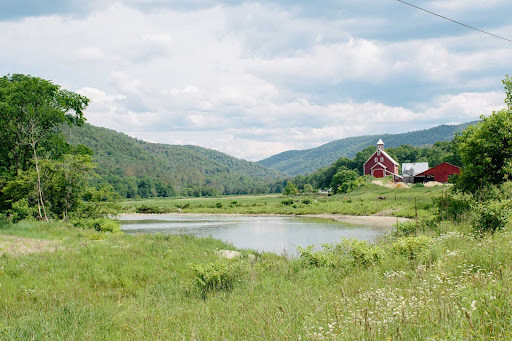
Vermont's first green agritourism enterprise, Liberty Hill Farm , a family-run dairy farm in the picturesque town of Rochester, has been welcoming tourists for nearly 40 years, many of whom return many times over to milk cows, bottle-feed calves, and go hiking in Green Mountain National Forest. The hearty breakfast of farm-fresh eggs and cheese, as well as a home-cooked dinner keep agritourists properly fueled. After a day filled with outdoor activities, guests can watch the sunset from a rocking chair on the porch and catch some quality zzzs in a cozy room inside the 1825-built Greek Revival main house.
2. Beach Plum Farm (Cape May, New Jersey)

Drive two miles west of historic downtown Cape May and you’ll find Beach Plum Farm . To reap grounding benefits of fostering a deeper connection to nature and farm life, chores here include feeding animals, collecting eggs, planting, and harvesting. There are interactive classes on topics such as beekeeping and flower-arranging in season. The property is also well known for farm-to-table dinners. Besides hands-on educational experiences, enjoying the fresh air, and eating delicious food, guests have the opportunity to snooze soundly in cottages and hemlock beam barns.
3. Babylonstoren (Simondium, South Africa)

One of the oldest Cape Dutch farms in South Africa, Babylonstoren has a huge garden with vegetables, stone fruits, citrus, herbs, and even a prickly pear maze. Gardener-led walking tours to see the plants, bees, ducks, and chickens are available.
Babel, an old cowshed turned farm-to-fork restaurant, boasts one of the best and most bountiful breakfast spreads ever. Expect house-made granola, wood-fired country bread, hand-churned butter, pressed juices, and hyperlocal honey. Guests can hunker down in cottages with fireplaces and clawfoot tubs. Bathrooms here are stocked with hand-picked aromatherapy herbs. And nature-driven spa treatments round out the wellness offerings.
4. Southall (Franklin, Tennessee)
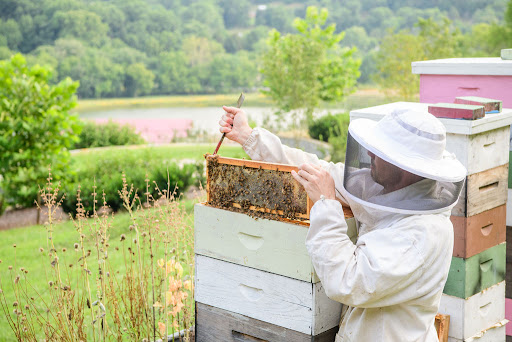
For travelers who crave a little luxury, Southall is an upscale farm resort not too far outside of Nashville worth checking out. The picturesque property offers gardens, greenhouses, a lake, apiaries, forest trails, and refined accommodations that make it an extremely relaxing atmosphere for stressed-out city dwellers to learn about and reconnect with nature. The farm-to-table experience ranks among the highlights for foodies keen to understand the journey from ground to plate—and then taste the proverbial fruits of their labors, as prepared by a talented chef. Many folks also gravitate toward pollinator programming that includes bee-hive tours and honey tastings.
5. Beltane Ranch (Glen Ellen, California)

Sonoma continues to lead the regenerative agriculture charge in the United States. Beltane Ranch , a sixth-generation operation in Glen Ellen, stands at the forefront of the movement. Efforts—which go well beyond sustainably to restorative practices that will benefit the land for generations—include using free-range chickens for pest control, composting initiatives, maintaining wildlife corridors, planting cover crops, and employing sheep (aka “woolly weeders”) to promote soil fertility. Besides the applaud-worthy ecological endeavors, this 105-acre agricultural preserve is a wonderful place to unwind under the shade of ancient oaks, stroll through the vineyards and heirloom gardens, sip estate-grown wine, sample olive oil, and rest in a landmark inn.
6. São Lourenço do Barrocal (Alentejo, Portugal)

Another plush yet pastoral choice, São Lourenço do Barroca is a family-operated agritourism that dates back more than 200 years. The sprawling plot comprises a 19th-century farmhouse, spa, stables, scenic trails, a winery, an organic garden, and a farm-to-table restaurant that sources vegetables, fruits, and olive oil grown and produced right on-site. Guests have the opportunity to participate in a spate of activities, such as horseback riding, cycling, bird-watching, and stargazing (the estate sits within the Alqueva Dark Sky Reserve ). Overnight options include rooms, suites, and cottages—all refurbished, but still true to traditional craftsmanship with elements like terracotta floors.
7. Tabula Rasa Farms (Carlton, Oregon)
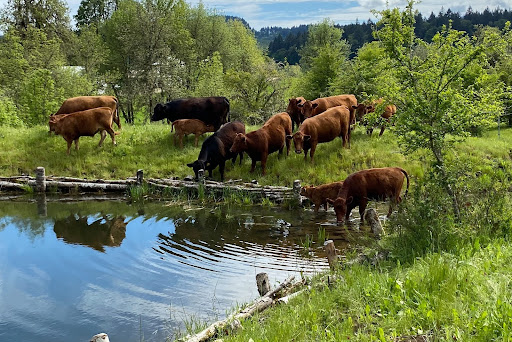
Situated in the heart of the Willamette Valley, Tabula Rasa Farms is rooted in sustainability and respect for the land and its creatures. It’s well regarded for humane, grass-fed beef, heritage-breed pork, and pasture-raised laying hens. The plant-based set will find plenty to satisfy thanks to the regenerative approach to agriculture that yields fresh, flavorful vegetables. Farms tours to meet all animals, learn about rotational grazing, and witness water conservation efforts first-hand are a huge hit. For overnight guests, there’s a hilltop farmhouse with sweeping vistas and a fitness center.
8. EBBIO (Tuscany, Italy)

EBBIO , an organic and sustainable farmhouse surrounded by an evergreen forest in Tuscany, is beloved among visitors who love foraging for wild asparagus and edible flowers. Truffle hunts lure travelers between September and November. With essential-oil making, cooking classes, jam workshops, art therapy, horseback riding, and farm chores like feeding chickens, the enriching on-site activities never seem to end. The ecologically oriented estate also hosts yoga retreats.
9. Mountain Goat Lodge (Salida, Colorado)
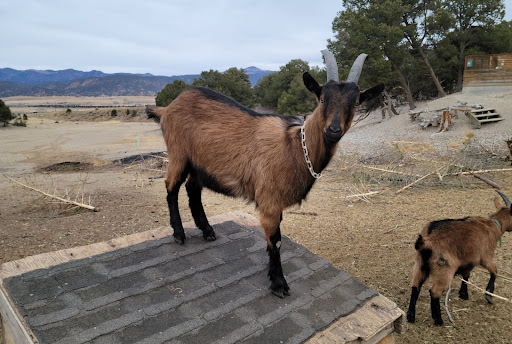
Tucked away on 20 acres at the foot of the Sawatch Mountain Range in the high desert of Colorado, Mountain Goat Lodge invites visitors to interact with dairy goats (and even bottle-feed kids). More than just simply looking adorable and bringing a smile to guests’ faces, these cute critters supply milk for housemade Greek-style yogurt, chevre, fresh mozzarella, feta, and paneer—all of which is up for grabs at breakfast. The cheese-making workshops are wildly popular. Guests can also learn new skills to bring back home by taking classes on raising backyard chickens and goat husbandry. When it’s time to call it a night, cozy rooms and suites await.
10. Cucumbi Farm (Alentejo, Portugal)
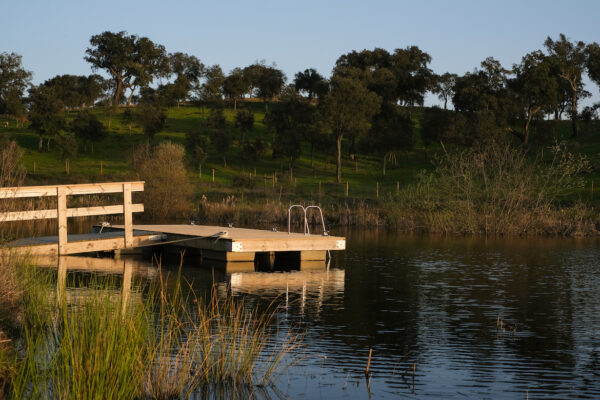
A soulful reflection of the agrarian roots and spirit of Alentejo, every aspect of Cucumbi Farm ties to the untouched region it calls home. It’s rustic and relaxing, with an emphasis on returning to simplicity. There are expansive fields to explore, crops to harvest, sheep and chickens to feed, and a saltwater pool to cool off in between chores and strolling the enchanting grounds. While the whitewashed apartments and suites—which don’t have TVs in order to help guests fully embrace the slower pace and unplugged nature of things—are all named after animals that reside on the herdade.
Loading More Posts...
The Beach Is My Happy Place—and Here Are 3 Science-Backed Reasons It Should Be Yours, Too
Your official excuse to add "OOD" (ahem, out of doors) to your cal.
4 Mistakes That Are Causing You to Waste Money on Skin-Care Serums, According to an Esthetician
These Are the Best Anti-Chafing Denim Shorts—According to Some Very Happy Reviewers
{{ successMessage }}
Please wait a moment...

Agritourism in the Philippines: Forging New Heights as an Agritourism Destination
by Leslie | Oct 14, 2020 | Blog | 1 comment
Given the country’s fertile soil, tropical climate, abundant natural resources, rich farming culture and genuine hospitality of Filipinos, the Philippines is very well-positioned for agritourism.
Agriculture has always been part of Filipino culture. This is who we are – a country with abundant natural resources, inhabited by warm hospitable people who know how to till the land. Acknowledging its importance and proudly sharing it with the world only intensifies our great love for the Philippines.

A local farmer planting rice at Cadapdapan Rice Terraces in Anda, Bohol
Philippines: One of the Top 8 Agritourism Destinations in the World
For a country that excels in both industries such as agriculture and tourism, there is no doubt of our potential to become an “agritourism destination”. In fact, the Philippines was named as one of the Top 8 Agritourism Destinations in the World in 2018. Also joining the list are countries such as Taiwan, Hawaii, Tuscany, Grenada, Mallorca, California, and Brazil.
What makes the Philippines stand out are factors such as multiple agritourism sites, huge plantations scattered across its vast archipelago, exotic tropical fruits and our English-speaking population.

Tropical fruits that are abundantly grown in the Philippines | Source: Shutterstock | Photo by: Anna Pustinnykova| Shutterstock ID: 586666994
Being part of the Top 8 list helps propel our initiatives to escalate this niche. Our inclination to agritourism can help create better ways to ensure that the tourism industry is made more sustainable.
DOT’s Direction: Agritourism in the Philippines
The Department of Tourism (DOT) along with the Department of Agriculture (DA) are driven to bring agritourism in the Philippines into new heights.
It might be interesting to note that, our current DOT Secretary Puyat also served as the undersecretary of the Department of Agriculture (DA) for 12 years – this creates a strong foundation making her the rightful person to maneuver us towards agritourism. She said, “Our tourism industry in the Philippines has been promoting the inclusive development of the countryside, supporting our farmers, Indigenous Peoples, women, and other marginalized groups through sustainable programs that uplift and empower.” | Source: Department of Tourism
Agritourism: Agriculture Tourism Defined
Agritourism came from the two words “ agriculture ” and “ tourism ”.
Agri-tourism (also referred to as “farm tourism” ), as defined by DOT, is a form of tourism activity conducted in a rural farm area which may include tending to farm animals, planting, harvesting and processing of farm products. It covers attractions, activities, services and amenities as well as other resources of the area to promote an appreciation of the local culture, heritage and traditions through personal contact with the local people. | Source: Bureau of Agricultural Research
Agritourism, therefore, puts emphasis on showcasing nature and the good harvest. It usually takes place in rural or less developed areas where agriculture is the main source of income of the local community. It allows the local community to share and invite people to come, see, participate and appreciate the agricultural landscape and cultural heritage of the place.

The endless land of pineapple plantation in Bukidnon

Agri-Tourism is the best option for farmers to prosper now a days. So how our Govt. Can help us develop this big opportunity. We have a farm suited for the idea.
Philippines’ Leading Tour Operator Nominee

Recent Posts
- Savoring Cebu: Unveiling the Top 10 Restaurants and Bars for Epicurean Adventures
- Palawan’s Paradise: A Tale of Beauty from Coron to El Nido
- A Beginner’s Journey into the Underwater World: My First Scuba Diving Experience in the Philippines
- Rediscovering the Hidden Gems of Carnaza Island
- Ecotourism and Eco-sustainability: Unlocking the Potential of the Philippines
Recent Comments
- bong on Whale Shark Philippines | Why Choose Donsol Over Oslob
- whoiscall on Devie’s Top 10 Hidden Gems in the Philippines
- Jm on Christmas in the Philippines: 10 Unique Filipino Christmas Traditions
- Anik sarma on Rice Cooker Recipes: Easy Quarantine Cooking
- Ian on Rice Cooker Recipes: Easy Quarantine Cooking


IMAGES
VIDEO
COMMENTS
Agri-ecotourism or agro-ecotourism is a mix of both ecotourism and agritourism. It's a form of tourism that involves visitors participating in sustainable farming and learning about local produce. Known to be socially responsible and eco-friendly, the popularity of agri-ecotourism continues to grow as people look for new experiences outside ...
Ecotourism has benefited destinations like Madagascar, Ecuador, Kenya, and Costa Rica, and has helped provide economic growth in some of the world's most impoverished communities.
Agro ecotourism involves observing the indigenous people whose farming and herding practices that are part of their customary knowledge and cultural identity can be experienced firsthand (Figure 3). Experiencing authentic local tastes is an important part of what makes an eco-holiday enjoyable and memorable therefore traditional food has an ...
VISITOR GOALS OF ECO/AGRO ECO TOURISM: LEARNING EXPERIENCES • Particularly important in agro eco tourism. Farmers have vast agricultural and ecological knowledge! • "Sustainability" movement is extremely popular and growing in the USA, Europe and other locations that have much to offer in terms of cultural exchange and financial
In general, "agro-tourism" and "agro-ecotourism" are interchangeable. Among the tourism industries that leverages rural culture as a draw for visitors is agro-tourism. All it is agriculture through tourism, or rather, tourism through agriculture commercialization. Bangladesh has great potential for the development of agro-tourism.
Agro-ecotourism is a type of tourism that makes use of rural culture as a tourist draw. It has taken on a new meaning as a possible source of income and employment. The synergy between tourism and ...
Agri-ecotourism, also known as agro-ecotourism, combines ecotourism with agritourism. Agri-ecotourism is growing in popularity as people seek fresh experiences outside of cities. It's a kind of tourism that includes tourists learning about local food and engaging in sustainable farming. It is known for being socially responsible and environmentally sustainable. Agri-ecotourism...
Like Ecotourism, adventure tourism is an area that is experiencing growth as people's appetite for ever newer and more unique experiences changes. ... It also covers various tourism attractors, including heritage tourism, agro-rural tourism, natural/scenic attractions, man-made attractions, spiritual/ religious tourism, wildlife tourism ...
Agro-tourism, also called green tourism, is a recent concept that reiterates the strengthening of farmers to get additional income than food production.
According to the Food and Agriculture Organization, Agritourism is 'The symbiotic relationship between tourism and agriculture.'. In a simple context, agritourism also known as agrotourism, is a form of tourism which activities are focused directly with agriculture, and utilises the unique offerings of rural and agriculture rich communities.
This of course means an economic boost for rural areas and is an example of a positive economic impact of tourism! Agritourism is also a more eco-friendly and immersive way to travel. It allows people to have experiences they may not get elsewhere, meet local people, see 'off the beaten track' locations and more.
Ecotourism is a form of tourism marketed as "responsible" travel (using what proponents say is sustainable transport) to natural areas, conserving the environment, and improving the well-being of the local people. The stated purpose may be to educate the traveler, to provide funds for ecological conservation, to directly benefit the economic development and political empowerment of local ...
Agritourism. University of California researchers define agricultural tourism (agritourism) as any income-generating activity conducted on a working farm or ranch for the enjoyment and education of visitors. It includes the interpretation of the natural, cultural, historic, and environmental assets of the land and the people working on it.
The development of sustainability of all forms of tourism is a current topic in the world, so understanding the components of sustainable development of agro-tourism is essential for a destination's survival in the tourist market and meeting the demands of the modern tourist consumer [1,2].Success in agro-tourism through the principles of sustainability requires knowledge in many economic ...
Community-based agro-ecotourism is a tourism activity that utilizes the agricultural, natural, and cultural potential of environmentally friendly rural communities as tourism objects whose management is carried out by the local community. This study analyzes the sustainability and sensitivity of attributes that affect community-based agro-ecotourism in West Java. The study used a survey method ...
Agritourism Is the Concept of Vacationing on a Farm—Try It Out at These 10 Pastoral Properties. Agritourism is a portmanteau of agriculture and tourism. The concept, affiliated with ecotourism ...
Agro-ecotourism is a long-term tourism development strategy in rural areas that allows visitors to learn about agricultural situations, agricultural work, local goods, traditional food, the daily ...
Eco-agri tourism is a combination of 'Ecotourism' and 'Agri-tourism'. This type of tourism aims to sustain the culture and nature of the place while promoting agriculture as the tourism attraction. Both ecotourism and agri-tourism were considered as Nature- based Tourism because it both depends directly to nature.
"agro", "agri", or "rural" tourism, ascertain the implications of relevant scientific articles and suggest future research avenues related to sustainability and sustainable development issues. A two-step systematic approach was followed in identifying "agrotourism", "agro tourism", "agro-tourism",
Ecotourism and agrotourism have contributed to green economic development as well as to the development of plant variety protection. Agrotourism is a form of commercial enterprise that links ...
development of the agro-tourism centres and it serves him and create additional income source. Fig1. Ideal location for Agro-tourism centres There are three main forms of rural tourism which bring benefits both for tourists and for the local community Location for Agro-Tourism Centre 3. Away from city 6. Near to local market, hotels etc. 2.
Here are some of the DOT-Accredited Farm Sites in the Philippines: Layog Country Farm - Mountain Province. Terra Verde Eco Farm - Maragondon, Cavite. Amancio's Dairy and Produce Farm - Cordon, Isabela. Tam-An Eco-Tourism Farm - Bayombong, Nueva Vizcaya. The Farmhouse by EDL - Capas, Tarlac. Amadeo Nurture Farmacy - Cavite.
1) The management plan for each area proposed for agro eco-tourism should be prepared through professional landscape architects and rural planners and in consultation with the local community as well as other directly concerned. 2) To avoid intersectoral and interstate conflicts, integrated planning should be adopted for e.g.